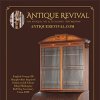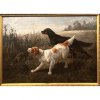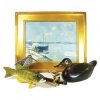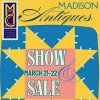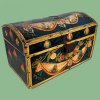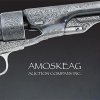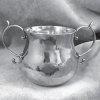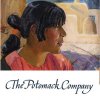A Fresh Show Overlooking the Hudson River
April 7th, 2019
Antiques on the Hudson at Lyndhurst, Tarrytown, New York
What better venue can an antiques event have than a location that is historical, easy to reach, with great views of one of the world’s most famous rivers and mountains, and a house museum filled with period antiques that was hosting a spectacular flower show with imaginative presentations on the same weekend? That may be what Frank Gaglio of Barn Star Productions thought when, a year ago, he launched Antiques on the Hudson at Lyndhurst.
According to Gaglio, “Lyndhurst director Howard Zar visited our Antiques at Rhinebeck show and contacted me the following week. He wanted to know if I would be interested in visiting Lyndhurst and consider running an antiques show there on their opening weekend of the estate. I told Howard I was familiar with the property, and many decades ago, I had participated in an outdoor antiques show promoted by Russell Carrell on the property. I visited the site and was very enthusiastic at the possibilities, and the date worked out perfectly for us as well.”
Perfect is a word that fits the event. The show was as fresh as the floral displays in the flower show and as classy as a national trust property can beLyndhurst is a Gothic Revival mansion, built in 1838 and lived in by magnates and millionaires, among them railroad magnate Jay Gould. This estate on 67 acres always gets a “wow” reaction from visitors, both outside and inside the mansion where Gothic arches frame every vaulted ceiling and Gothic pillars every wall. Not to forget Gothic stained-glass windows, and 19th-century landscape design, including a greenhouse—now only the “ribs” of the exterior remain—gardens, walks, statuary, and a bowling alley.
The combination event of a flower show and antiques show was a win-win. There were lots of younger patrons, many with kids in strollers or arms, and they were buying—garden furniture, jewelry, prints, paintings, and Windsor chairs.
When asked about sales, Gaglio said, in addition to what we listed, “Maps, contemporary furniture, mid-century modern, Oriental rugs, and occasional furniture went out the door. Frank Oppel sold over 30 maps. Knollwood Antiques sold a pair of beautiful mirrors. Glen Leroux sold mid-century furniture and high-end jewelry, as did James Levinson. The Milnes sold garden urns and a wonderful swordfish weathervane. Jon Rider sold two pieces of furniture, and Stone Block sold a marble-top table plus other items.”
The show was held April 6 and 7, in a white tent connected to the historical carriage house. Gaglio commented, “When I saw the tent facility with the vaulted draped ceiling, five chandeliers, flooring of black Astroturf, and very accommodating logistics for dealer load-in, I was ecstatic about the possibilities.”
All but three of the 27 dealers from Montreal to Florida were repeats from last year. Gaglio added that he would have had 100% returns but for a competing event the next weekend that became a conflict caused by construction and thus caused a change of date. “We hope there will not be that conflict next year,” he said.
Knowledgeable and ready to have good conversations, with price tags featuring extensive documentation on their offerings, the dealers were a delight to interview. Their booths were alluring, colorful, and catchy, proving that bigger is not always better—more time to look and talk, less rush to cover everything.
When I asked those who had done the show a year ago how selling was that time, they said fair enough to come back for sure. There are many ways to sell when one exhibits at an antiques show. One dealer had a Windsor chair in her booth with a sold sign. When I inquired, she explained that she had a few pieces on her Facebook page before the show saying she was bringing them to the show; she got calls, and she sold them. It’s another way to get people to come to the show, maybe buy other things, and meet dealers with a list of “what I am looking for next.”
to sell when one exhibits at an antiques show. One dealer had a Windsor chair in her booth with a sold sign. When I inquired, she explained that she had a few pieces on her Facebook page before the show saying she was bringing them to the show; she got calls, and she sold them. It’s another way to get people to come to the show, maybe buy other things, and meet dealers with a list of “what I am looking for next.”
The variety shown was expansive, from vintage ties and handbags to Federal furniture and fine silver. It is interesting to see the special things one has owned for decades appear in top-notch antiques shows. Maybe we have better taste than we thought and a good eye for decorative arts.
Although the lasting visual impressions were made by the graphic booth arrangements and the fine pieces that filled them, the thing I will never forget is the dealers. What a treat to meet pros and veterans whose knowledge of what they were selling was extraordinary. “Take a picture of the price tag, Fran,” they said, since it had all the information I needed, and I could not write legibly that fast. Detail upon detail, so that the buyer would truly know what he was buying.
How was attendance? Gaglio said that “the Lyndhurst staff helped sell tickets online, and on the first day they exceeded 300, which was the most online sales we have ever had for a show—very exciting news. Without question our gate was up significantly from last year, which in itself was outstanding for a first-time show, and I attribute this to our increased advertising on social media, e-mail blasts, print ads, press releases, exhibitor show card mailings, and radio spots.”
Gaglio said, “We have an incredible working relationship with Howard Zar, the Lyndhurst staff, and property management crew that all contribute to the success of this event. Having the show on the opening weekend of Lyndhurst—plus the flower show—gives attendees several reasons to come out and join us. There are floral demonstrations, high tea—which was a sellout both days—jewelry appraisals by Rago Arts and Auctioneers, and a wonderful walking tour of the antiques show by TV celebrity, author, and style maker Bob Richter, followed by a signing of his new book, Vintage Living. Three executive shuttle buses making it easy for guests to get from one event to the other, a show café, and stunning Hudson River views all contributed to a great spring weekend that we are looking forward to presenting again next year.”
For more information, visit the website (www.barnstar.com), and save the first weekend in April 2020.

This photo of Marlene Dietrich was offered for $3200 by Glen Leroux of Westport, Connecticut. By George Hurrell, the photograph came from the collection of Alan Rich.

Lyndhurst Mansion, a spectacular “castle” overlooking the Hudson River in Tarrytown, New York. Legend has it that Tarrytown was so named as the women felt the men were “tarrying” in town. Just a half-hour by train from downtown Manhattan or a bit longer by car depending on the traffic, Tarrytown is the stuff of many legends, as its neighbor Sleepy Hollow can attest.

Gerald Wright is the owner of Rita Ford Music Boxes, New Providence, New Jersey. How he came to buy the business from Rita Ford, a friend of Lilian Nassau (of Tiffany fame), is quite a story. Rita Ford’s shop, specializing in music boxes and automatons, was on Madison Avenue in New York City beginning in 1947. Wright met Ford at a recital in Carnegie Hall where he played the trombone. They talked, and when she said she needed someone to help in her shop in 1983-84, he began to work there. Lots of celebrities were her clients. She stayed on as owner until 1991, when he bought the business from her. When Ford died a few years later, the New York Times wrote an obituary. She was notable because in the 1950s on Madison Avenue very few women had their own businesses. Wright continued the storefront business until 2018, when Manhattan rents became too expensive. He now does a few shows a year and has a website. He does repairs as well, and he is among the best! This automaton was $55,000.

The booth of Hawthorne Fine Art, New York City, had impressive paintings covering the walls, including some of the Hudson River. However, we were drawn to this portrait of a charming young lady by Walter Cox (1867-1930). The signed oil on canvas, 30" x 25", is a piece you could hang in any home. It was available for $15,000.

This large $950 bunny flanked by colorful retro toss pillows, $850 the pair, and rattan garden furniture was front and center in the booth of Find Weatherly, Stamford, Connecticut.

This dreamlike surrealistic piece by George Marinko (1908-1989), was offered by David Smernoff of New Haven, Connecticut. Marinko was one of the founders of the Surrealist style in America.

Ever see a lamppost like this one complete with squirrel? From the booth of Joan Bogart of Long Island, New York, it was priced at $3150.

European Hotel Silver, Darien, Connecticut, (what an interesting specialty) had three women to help customers. Left to right, Mary Crawford, Kimberly Cordero, and Ginger Kilbane, who owns the company.

Silver, including this flatware setting for 12 (on the table in front of exhibitor Peter Murphy), British sterling, London, 1919, was offered for $4900, and an 18th-century French screen made from tapestry fragments was available for $2900 from P.D. Murphy Antiques, Bath, Maine. Murphy told us he had an excellent show and had sold French furniture and silver in his first time participating in the show. He also commented on the number of young couples in their 30s shopping for items to fill houses or apartments.

Brennan & Mouilleseaux, Briarcliff Manor, New York, exhibited very dramatic pieces, such as this pair of cast-iron lions.

Hanes & Ruskin, Old Lyme, Connecticut, showed this 1875 mahogany server, 36" x 20" x 37", as well as fine art and silver—classic items in the always classic booth of Hanes & Ruskin. The Windsor chair to the far left sold.

Bob Richter, author of the book Vintage Living, stood behind Lee Hanes as he explained something to the group during Richter’s tour of the show.

Suzan McClellan-Whiting of Woodstock, New York, has a smile that is as welcoming as her manner. She is shown standing beside a print by her father, John Ward McClellan (1908-1986). The print, Zeus Visited Danae in a shower of gold. She gave birth to an egg containing Helen of Troy, was a reasonable $325. Works by John McClellan are in museums, including the British Museum, the Metropolitan Museum of Art, the Smithsonian Institution, and the Whitney Museum of American Art.

The Milnes of At Home Antiques, Kingston, New York, always turn up the unusual, such as these three statues, Three Graces, $9800.

Prints and maps (especially of local areas) were hot items in the booth of Frank Oppel of Stamford, Connecticut. Prices began at $55 each and went up to three and four figures.

Available from Michele Fox of Weston, Connecticut, were a 48-star American flag, circa 1920, for $1800 and an Ike campaign hat for $350.
Originally published in the June 2019 issue of Maine Antique Digest. © 2019 Maine Antique Digest
